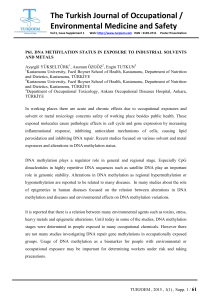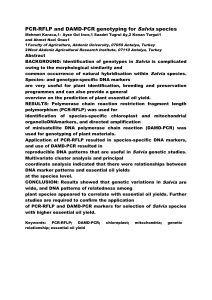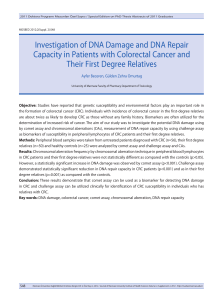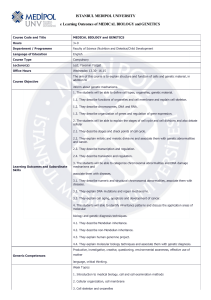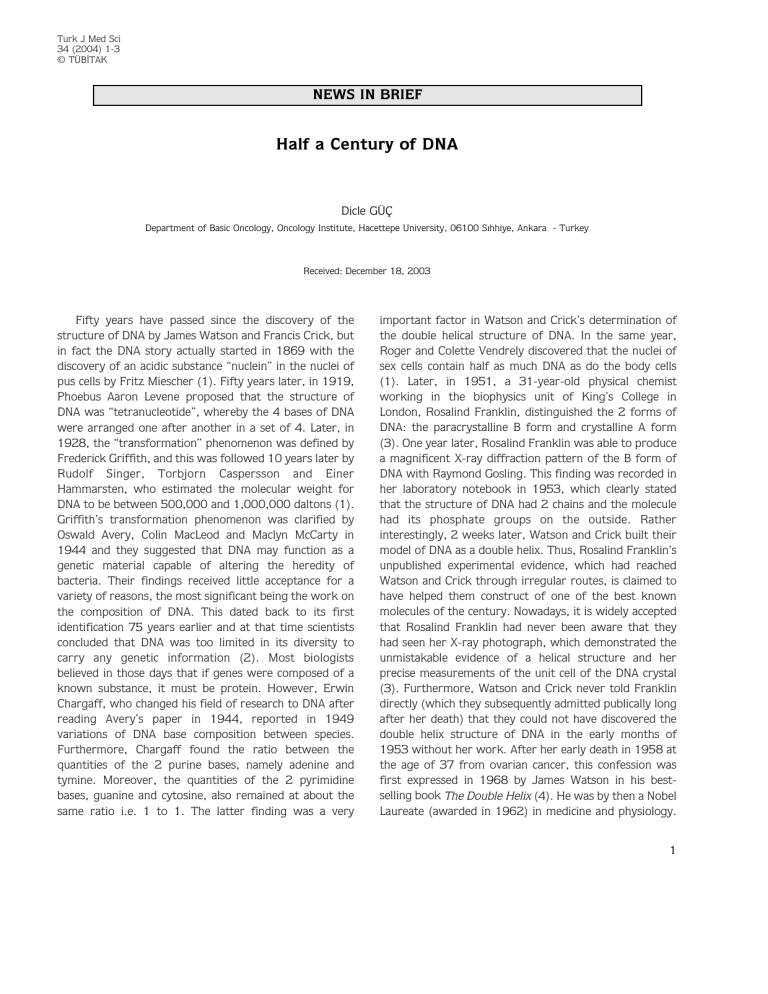
Turk J Med Sci
34 (2004) 1-3
© TÜB‹TAK
NEWS IN BRIEF
Half a Century of DNA
Dicle GÜÇ
Department of Basic Oncology, Oncology Institute, Hacettepe University, 06100 S›hhiye, Ankara - Turkey
Received: December 18, 2003
Fifty years have passed since the discovery of the
structure of DNA by James Watson and Francis Crick, but
in fact the DNA story actually started in 1869 with the
discovery of an acidic substance “nuclein” in the nuclei of
pus cells by Fritz Miescher (1). Fifty years later, in 1919,
Phoebus Aaron Levene proposed that the structure of
DNA was “tetranucleotide”, whereby the 4 bases of DNA
were arranged one after another in a set of 4. Later, in
1928, the “transformation” phenomenon was defined by
Frederick Griffith, and this was followed 10 years later by
Rudolf Singer, Torbjorn Caspersson and Einer
Hammarsten, who estimated the molecular weight for
DNA to be between 500,000 and 1,000,000 daltons (1).
Griffith’s transformation phenomenon was clarified by
Oswald Avery, Colin MacLeod and Maclyn McCarty in
1944 and they suggested that DNA may function as a
genetic material capable of altering the heredity of
bacteria. Their findings received little acceptance for a
variety of reasons, the most significant being the work on
the composition of DNA. This dated back to its first
identification 75 years earlier and at that time scientists
concluded that DNA was too limited in its diversity to
carry any genetic information (2). Most biologists
believed in those days that if genes were composed of a
known substance, it must be protein. However, Erwin
Chargaff, who changed his field of research to DNA after
reading Avery’s paper in 1944, reported in 1949
variations of DNA base composition between species.
Furthermore, Chargaff found the ratio between the
quantities of the 2 purine bases, namely adenine and
tymine. Moreover, the quantities of the 2 pyrimidine
bases, guanine and cytosine, also remained at about the
same ratio i.e. 1 to 1. The latter finding was a very
important factor in Watson and Crick’s determination of
the double helical structure of DNA. In the same year,
Roger and Colette Vendrely discovered that the nuclei of
sex cells contain half as much DNA as do the body cells
(1). Later, in 1951, a 31-year-old physical chemist
working in the biophysics unit of King’s College in
London, Rosalind Franklin, distinguished the 2 forms of
DNA: the paracrystalline B form and crystalline A form
(3). One year later, Rosalind Franklin was able to produce
a magnificent X-ray diffraction pattern of the B form of
DNA with Raymond Gosling. This finding was recorded in
her laboratory notebook in 1953, which clearly stated
that the structure of DNA had 2 chains and the molecule
had its phosphate groups on the outside. Rather
interestingly, 2 weeks later, Watson and Crick built their
model of DNA as a double helix. Thus, Rosalind Franklin’s
unpublished experimental evidence, which had reached
Watson and Crick through irregular routes, is claimed to
have helped them construct of one of the best known
molecules of the century. Nowadays, it is widely accepted
that Rosalind Franklin had never been aware that they
had seen her X-ray photograph, which demonstrated the
unmistakable evidence of a helical structure and her
precise measurements of the unit cell of the DNA crystal
(3). Furthermore, Watson and Crick never told Franklin
directly (which they subsequently admitted publically long
after her death) that they could not have discovered the
double helix structure of DNA in the early months of
1953 without her work. After her early death in 1958 at
the age of 37 from ovarian cancer, this confession was
first expressed in 1968 by James Watson in his bestselling book The Double Helix (4). He was by then a Nobel
Laureate (awarded in 1962) in medicine and physiology.
1
Half a Century of DNA
He wrote in his book that “Rosy, of course, did not
directly give us her data. For that matter, no one at
King’s realized that they were in our hands”. Although in
1953 Nature published 7 papers on the structure of DNA
and these reports on DNA structure were written by
James Watson and Francis Crick (5,6), Rosalind Franklin
and Raymond Gosling (7,8), Maurice Wilkins, W.E. Seeds,
Alec Stokes and Herbert Wilson (9,10) and Bertil
Jacobson (11), the Nobel prize in medicine was awarded
in 1962 to only James Watson, Francis Crick and Maurice
Wilkins for their work on DNA.
The unique importance of the finding of the DNA
structure is due to the light it sheds on the inheritance of
genetic material, replication, repair, diversity and the
evolution of species. In a broader sense, its discovery has
united genetics with biochemistry, cell biology and
physiology. Briefly, the model for the DNA double helix
proposed by James Watson and Francis Crick is based on
2 paired DNA strands that are complementary in their
nucleotide sequence. The model had striking implications
for the process of DNA replication and DNA
recombination (12). Before the discovery of DNA’s
structure it was impossible to speculate about the
molecular mechanisms of DNA replication and
recombination, but the discovery of complementary base
pairing between DNA strands indicates that 2 strands of
a DNA molecule could serve as a template for the
synthesis of new complementary strands, the sequence of
which would be dictated by the specificity of base pairing.
As a result, any part of the sequence can be used either
to create or to recognize its partner nucleotide sequence
and these 2 functions are central in DNA replication and
recombination (12,13). Another important dynamic state
of DNA is the restoration of altered DNA to its normal
state, which is called DNA repair (14). During evolution
there is a fine line between genomic stability and
instability and of mutation and repair. Twenty years after
the discovery of DNA’s structure, Francis Crick wrote in
Nature that “we totally missed the possible role of
…(DNA) repair although… I later came to realize that
DNA is so precious that probably many distinct repair
mechanisms would exist” (15).
Watson and Crick’s double helix model has also
prepared the basis for the Human Genome Project, which
is the most remarkable project of the century. This
project has accumulated a tremendous amount of
2
information about DNA sequences. It is now time to
convert the information into knowledge of organisms.
Finally, as an immunologist, I would like to stress the
importance of the discovery of DNA’s structure in the
transformation of immunology over the past 50 years.
One of the most striking examples is the diversity of
antibodies. An individual is capable of making a
tremendous number of antibodies, each with a distinct
specificity (16). During the maturation of B-lymphocytes
a group of short genes are rearranged and come together
at the DNA level. This process is caused by the production
of many structurally distinct, up to 109, antibodies by B
cells. As the rearrangement is mostly random, each
lymphocyte makes different choices and thus the result is
a broad repertoire of lymphocytes reactive to different
antigens (17). The puzzle of antibody diversity cannot be
solved without the double helix information.
The celebration of this particular molecule is not only
related to its remarkable scientific importance but also to
the fact that as Martin Kemp from the Department of the
History of Art at Oxford said, “No molecule in the history
of science has reached the iconic status of the double helix
of DNA. Its image has been imprinted on all aspects of
society, from science, art, music, cinema, architecture and
advertising” (18). Even for artists, the charm of a form
that is both beautiful and full of all kinds of scientific and
social significance is quite considerable.
Since the late 1950s DNA has been a part of the daily
life. One may come across a sculpture or a Lego model of
the DNA double helix. Similarly, Salvador Dali painted
DNA in his Butterfly Landscape, the Great Masturbator in
Surrealist Landscape with DNA (1957-8) (18). Like him,
many artists have used the image of DNA in their designs
and paintings and DNA was included in the Millennium
Collection stamp designed by Mark Curtis and the
cosmetic industry recently came up with a perfume
named “DNA”.
Corresponding author:
Dicle GÜÇ
Hacettepe University, Oncology Institute,
Department of Basic Oncology
06100,S›hhiye, Ankara, Turkey
E-mail: [email protected]
D. GÜÇ
References
1.
Olby R. Quiet debut for the double helix. Nature 421: 402-405,
2003.
2.
3.
4.
10.
McCarty M. Discovering genes are made of DNA. Nature 421:
406, 2003.
Wilkins MHF, Seeds WE, Stokes AR et al. Helical structure of
crystalline deoxypentose nucleic acid. Nature 172: 759-762,
1953.
11.
Maddox B. The double helix and the “wronged heroine”. Nature
421: 407-408, 2003.
Jacobson B. Hydration structure of sodium deoxyribonucleic acid
and its physicochemical properties. Nature 172: 666-667, 1953.
12.
Alberts B. DNA replication and recombination. Nature 421: 431435, 2003.
13.
Cooper GM. Fundamentals of Molecular Biology, Heredity, Genes
and DNA in The Cell: A Molecular Approach, ASM Press
Washington DC, 1996, pp: 87-135.
Watson JD. The Double Helix: A personal account of the discovery
of the structure of DNA (Atheneum, New York, 1968). Northon
Critical Edition (ed. Stent, GS) published by Northon, New York,
London, 1980.
5.
Watson JD, Crick FHC. A structure for deoxyribose nucleic acid.
Nature 171: 737-738, 1953.
14.
Friedberg EC. DNA damage and repair. Nature 421: 436-440,
2003.
6.
Watson JD, Crick FHC. Genetic implications of the structure of
deoxyribonucleic acid. Nature 171: 964-967, 1953.
15.
Crick F. The double helix: a personal view. Nature 248: 766-796,
1974.
7.
Franklin RE, Gosling RG. Molecular configuration in sodium
tymonucleate. Nature 171: 740-741, 1953.
16.
8.
Franklin RE, Gosling RG. Evidence for 2-chain helix in crystalline
structure of sodium deoxyribonucleate. Nature 172: 156-157,
1953.
Abbas AK, Lichtman AH. Antibodies and Antigens in Cellular and
Molecular Immunology (5th Ed). Saunders, Philadelphia, USA,
2003, pp: 43-64.
17.
Nossal GV. The double helix and immunology. Nature 421: 440444, 2003.
18.
Kemp M. The Mona Lisa of modern science. Nature 421: 416420, 2003.
9.
Wilkins MHF, Stokes AR, Wilson HR. Molecular structure of
deoxypentose nucleic acid. Nature 171: 738-740, 1953.
3







